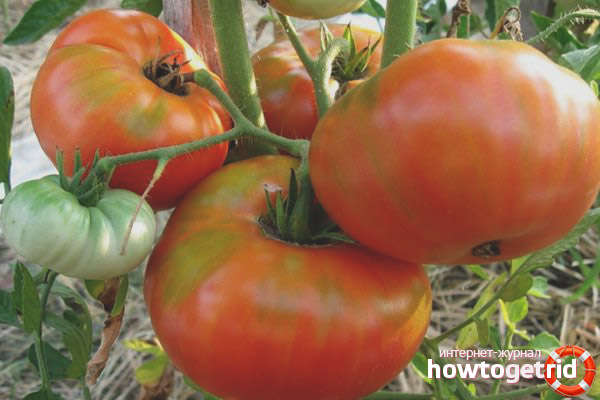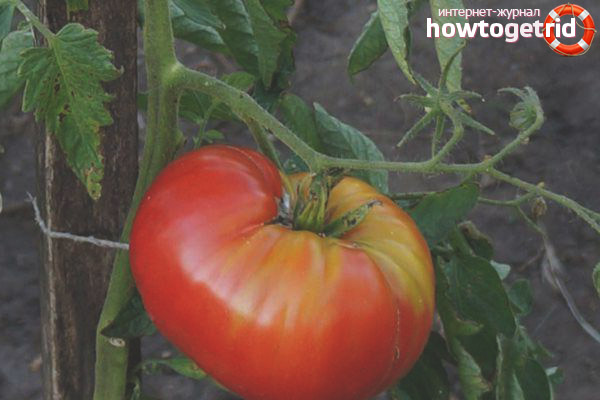The content of the article
The fruits have high taste, very sweet, fleshy. The advantage of these tomatoes is their resistance to late blight, and mosaic leaf disease. Tomatoes Lopatinsky use for harvesting for the winter, eat fresh. The first brush is bookmarked above the seventh sheet. Tomatoes are recommended to be grown indoors.
Description
Tomato Lopatinsky is indeterminate, has a large list of positive features. The fruits are large, dense, fleshy flesh, dense skin. The weight of plane-round fruits reaches 500 g. Plants intensively grow not only in height but also in width, so they plant them away from each other. Plants require the formation, removal of stepsons.
Growing seedlings
Sprouted seeds are planted in cups with soil to a depth of 1.5 cm (make a hole in the soil with a pencil, lower the seed and equalize). The soil for planting seeds should be loose and fertile, easily permeable to the roots.
- Glasses with seeds set in plastic boxes. You can use ready-made glasses - disposable for beer or cut them from plastic bottles (do not forget to puncture the hole for water drain at the bottom).
- Watered with water with a temperature of 20 to 25 degrees and sent to the greenhouse or any film shelter, where there is free space for 2-3 weeks. When the seedlings reach a height of 6 cm, they are fed with a solution of any mineral nitrogen-containing fertilizer: urea, nitrophos, etc. - Tomatoes are very fond of nitrogen in the early stages of cultivation. The proportions of the solution are as follows: 1 tbsp. a spoonful of fertilizer per 5 liters of water - this amount is enough for 6 boxes with seedlings, subsequent feeding - 1 time per week.
- The readiness of seedlings for transplantation is determined by the roots. They should almost completely braid an earthen ball in a glass.
It is recommended to use transparent glasses, so it is easier to observe the plant and root growth. The roots should not curl into rings at the bottom of the glass. If this happens, then the planted seedlings require nitrogen top dressing every 6 days in the first two weeks to give an impetus to increased growth, because if the seedlings have grown, they can stop growing after planting in open ground.
Outdoor cultivation of tomatoes
Tomatoes grow well on any type of soil, with the exception of heavy, clayey. Good predecessors for tomatoes will be cabbage, onions, garlic, zucchini, corn. You can also plant tomatoes on fresh manure made for late digging of the soil.
- Tomatoes are fed regularly (1-2 times a month) with a solution of nitrophosphate: 2 tbsp. tablespoons per 10 liters of water (this is enough for 25-30 plants). And although it is believed that tomatoes prefer mineral fertilizers, there is positive experience with the use of green nettle fertilizers.
- At the stage of flowering and fruit setting, watering should be quite frequent - 2 times a week in the dry season, plus mandatory weeding of weeds, mulching.
- In rainy years, due to the disease, up to 50% of the tomato crop can be lost. Gray rot affects leaves, ovary and fruits.
Preparing a place for tomatoes
Beds for tomatoes have been prepared since the summer. After harvesting the onions, the soil is not dug up, but leveled with a rake and white mustard is sown.
Seeds are covered with a rake in the soil, and after sowing, they must be watered. Shoots appear after 3-4 days. When the mustard blooms, trample it, crush it with a shovel, dig the bed.
In spring, when the soil permits, the bed is loosened with a chopper, the compost is scattered and covered with plastic wrap.The seeds are disinfected before sowing, immersed for 20 minutes in a warm ash solution.
Watering and feeding
If your region suffers from summer droughts and there are problems with water, then you need to know about the period in which tomatoes are in great need of watering - this is the period of fruit formation.
- Watering can be rare, but always plentiful. If watered superficially, the roots will concentrate near the surface of the soil, which greatly reduces resistance to drought and makes plants dependent on regular watering.
- After watering and top dressing, cultivation and hilling of plants are useful. If there is no rain, you will have to water the plants once a week.
- With a lack of moisture, premature dropping of leaves and drying of the ovaries occur. Sometimes it happens from a lack of potassium.
Tomato Lopatinsky is one of the leaders of the 2018 season in terms of productivity, resistance to heat, tolerance to sunburn, and taste.
Video: Determinant Tomatoes - Formation and Care











Submit